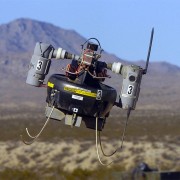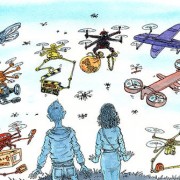THE scale and scope of the revolution in the use of small, civilian drones has caught many by surprise. In 2010 America’s Federal Aviation Authority (FAA) estimated that there would, by 2020, be perhaps 15,000 such drones in the country. More than that number are now sold there every month. And it is not just an American craze. Some analysts think the number of drones made and sold around the world this year will exceed 1m. In their view, what is now happening to drones is similar to what happened to personal computers in the 1980s, when Apple launched the Macintosh and IBM the PS/2, and such machines went from being hobbyists’ toys to business essentials.
That is probably an exaggeration. It is hard to think of a business which could not benefit from a PC, whereas many may not benefit (at least directly) from drones. But the practical use of these small, remote-controlled aircraft is expanding rapidly. After dragging its feet for several years the FAA had, by August, approved more than 1,000 commercial drone operations. These involved areas as diverse as agriculture (farmers use drones to monitor crop growth, insect infestations and areas in need of watering at a fraction of the cost of manned aerial surveys); land-surveying; film-making (some of the spectacular footage in “Avengers: Age of Ultron” was shot from a drone, which could fly lower and thus collect more dramatic pictures than a helicopter); security; and delivering things (Swiss Post has a trial drone-borne parcel service for packages weighing up to 1kg, and many others, including Amazon, UPS and Google, are looking at similar ideas).
Nor is commerce the only area in which drones are making a mark. A glance at the academic world suggests many more uses await discovery. Because drones are cheap, geographers who could never afford conventional aerial surveys are able to use them to track erosion, follow changes in rivers’ sources and inspect glaciers. Archaeologists and historians are taking advantage of software that permits drones fitted with ordinary digital cameras to produce accurate 3D models of landscapes or buildings. This lets them map ancient ruins and earthworks. Drones can also go where manned aircraft cannot, including the craters of active volcanoes and the interiors of caves. A drone operated by the Woods Hole Oceanographic Institution, in Massachusetts, has even snatched breath samples from spouting whales for DNA analysis. And drones are, as might be expected, particularly useful for studying birds. A standard shop-bought drone can, for example, be used unmodified for counting nests high in a forest’s canopy.
Public servants, too, are putting drones through their paces. In the case of nest-counting, the idea is not to disturb the wildlife in question. In Ottawa officials have taken the opposite approach, with a “goosebuster” drone that is fitted with speakers which play the calls of birds of prey. This has kept a city park on Petrie Island free from the hundreds of geese whose droppings were causing problems. Police in Michigan are considering using drones for mapping the scenes of accidents, so that roads can be reopened more quickly. And drones can save lives, as well as keeping parks clean and traffic moving. In June, for example, Frank Roma, a fireman, rescued two boys from a river in Maine with the help of a drone. The boys were stuck on a rock in the middle of a powerful current. Mr Roma employed a drone to carry a line out to them, along which he passed life jackets that they were able to put on before an inflatable boat went out to perform the tricky manoeuvre of picking them up.
Other roles for drones are more questionable. Their use to smuggle drugs and phones into prisons is growing. Instances have been reported in America, Australia, Brazil, Britain and Canada, to name but a few places. In Britain the police have also caught criminals using drones to scout houses to burgle. The crash of a drone on to the White House lawn in January highlighted the risk that they might be used for acts of terrorism. And in June a video emerged of KATSU, a pseudonymous graffito artist, using a drone equipped with an aerosol spray to deface one of New York’s most prominent billboards.
How all this activity will be regulated and policed is, as the FAA’s own flat-footed response has shown, not yet being properly addressed. There are implications for safety (being hit by an out-of-control drone weighing several kilograms would be no joke); for privacy, from both the state and nosy neighbours; and for sheer nuisance—for drones can be noisy. But the new machines are so cheap, so useful and have so much unpredictable potential that the best approach to regulation may simply be to let a thousand flyers zoom.
The trailblazers of the field—the Mac and the PS/2 of the drone world, if you like—are the AR and the Phantom. The AR, built by Parrot, a French company, became a bestseller in 2010. It is an easy-to-fly quadcopter that beams video back to a smartphone. Then, in 2013, a Chinese firm called DJI introduced the Phantom. That brought professional-quality aerial photography within the reach of general users. The Phantom’s latest incarnation, which costs less than $2,000, can shoot 20 minutes’ worth of footage before it has to land.
How long these two firms will dominate the world of drones is anybody’s guess. Andrew Amato of Dronelife.com, an American consultancy, says that the Phantom’s limited flight time makes it vulnerable. A drone that could fly for significantly longer—an hour, perhaps—would change the marketplace, as would one that was fitted with “sense-and-avoid” technology that would stop it running into obstacles by mistake. Researchers are busy in both these fields.
Sense-and-avoid, needed for drones to operate safely in shared airspace without close human supervision, is hard without extra sensors, such as radar. Using a drone’s own video camera to recognise objects in real time requires tremendous computing power. Some firms are, however, attempting to do just that. One, Bio Inspired Technologies of Boise, Idaho, is tackling the problem with a hard-wired neural network, a type of device that is good at learning things. This can, the firm’s engineers believe, be trained to recognise and avoid aerial obstacles. Alternatively, a conventional, if high-end, computer can be programmed with algorithms pre-designed to recognise and evade threats, by understanding how objects visible to a drone’s camera are moving. Percepto, a firm based in Tel Aviv, uses this approach, which it dubs “intelligent vision”. Percepto’s system might also be used to frame camera shots, by taking into account such things as lighting angles.
Whichever approach—training and learning, or pre-cooked recognition software—wins, drones that are able to understand their environments to even a limited extent will be a lot more useful. They could, for example, recognise their operator and home in on him when required. They might be set loose on frost-damaged roads, to look for potholes. They could be released to cruise over forests to spot fires early, or sent off to seek errant hikers who have failed to report in when expected.
Extended flight time will make all these putative uses more plausible, and many people are working on that, too. The most common approach is to switch in mid-air from being a helicopter, which relies on power-hungry rotor blades to stay aloft, to being an aeroplane, which gets its lift, more efficiently, from fixed wings.
The SkyProwler, from Krossblade, a firm based in Tempe, Arizona, looks like an aeroplane, but has four rotor blades which flick out of its body for vertical take-offs and landings. Dan Lubrich, the company’s boss, claims it is efficient at both hovering and forward flight, and says the transformation mechanism adds only about 10% to the drone’s weight. The SkyProwler cruises at 100kph (60mph) and has a flying time of 40 minutes. It can travel up to 25km, hover to shoot video or drop off a package when it arrives, and then return. It should go on sale in December.
Engineers at VTOL Technologies, a company spun out of the University of Reading, in Britain, are working on Flying Wing, a drone with a 120cm wingspan. Four ducted fans propel it forward in level flight, but their attitudes can be adjusted to allow them to provide lift directly. The upshot is a device which can be angled into the wind, to provide yet more lift. That permits it to hover in the way that gulls and other soaring birds do, with little expenditure of energy. VTOL estimates it will be able to do so for an hour, or remain in level flight for more than two hours.
The days of the Parrot/DJI duopoly thus look numbered. Mr Amato extends the comparison to PCs to the time when IBM’s grip on its half of the personal-computer duopoly faltered and numerous competitors rushed in. This did not, of course, prevent Apple’s business surviving on the back of a loyal and particular group of consumers, but it did mean that small computers became commodity products. Like a drone in a gust of wind, the future of the this market will have many twists and turns—but all the signs suggest that the air will soon be abuzz with machines.


